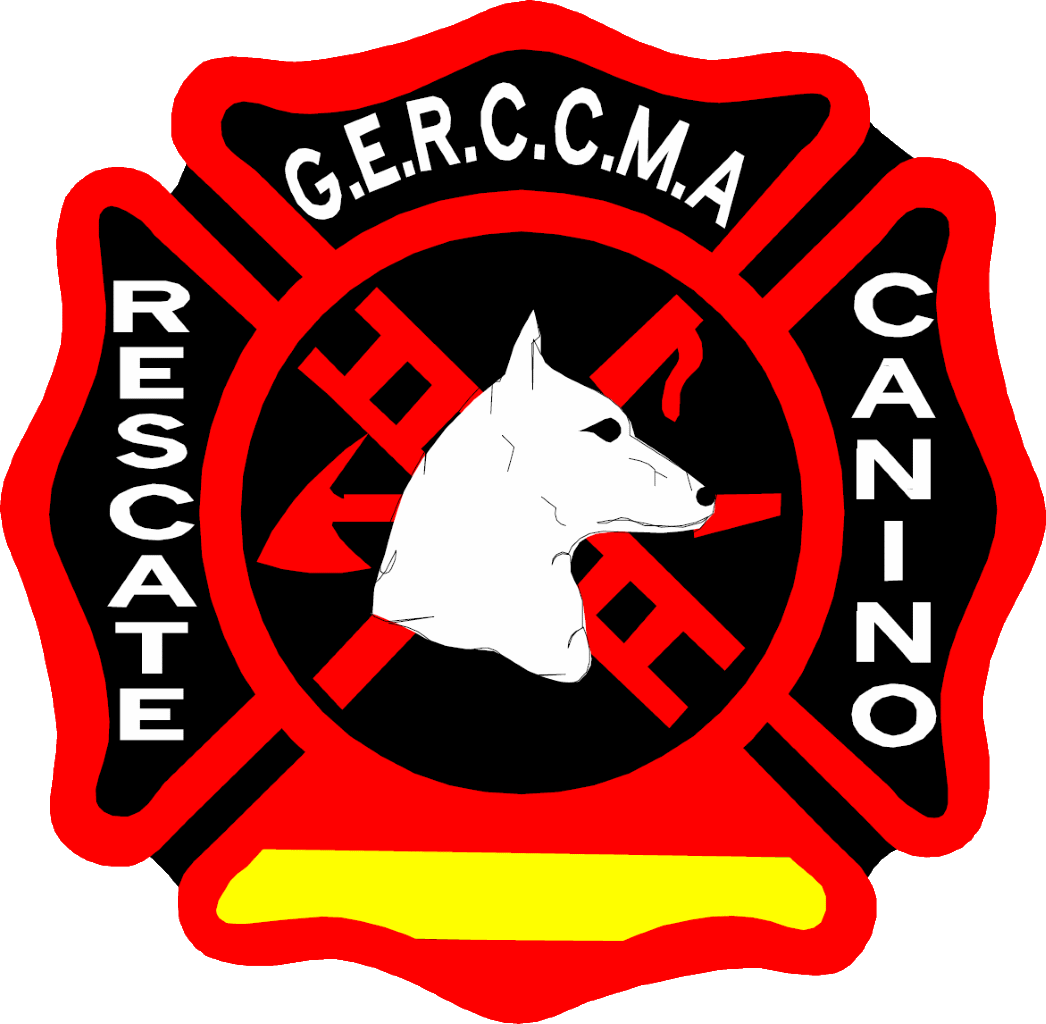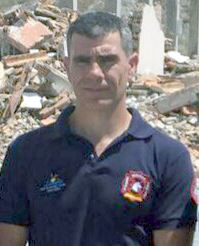The Arcón Method - optimising olfactory performance in search and rescue dogs
Interview with Javier Luque Sánchez



Hi Javier,
Just after the terrible earthquake occurred in Ecuador in April, I happened to read
a small article in a newspaper published on the Costa del Sol and that’s how I found
out that three firefighters from Estepona station had travelled to Ecuador with
rescue dogs to help after the disaster. The article just said these specialists
and their dogs used a “special method”, but I was intrigued by the word “special”,
so I started investigating… and I’ve got to say that what I read about the method
in question left me speechless. Can you please tell us what it’s all about?
Jaime Parejo García is the father of the Arcón Method. Right from the start, (1982-1994),
after 12 years of scientific research,
he decided that he was going to pass on the hugely significant results of all his
hard work as a researcher and inventor (rewarded by the United Nations and endorsed
by universities and scientific institutions as a major scientific and operational
step forward benefiting humanity)
in a humanitarian, urgent and tireless way to the competent institutions in countries
with special seismic risks, firmly driven by his unique, unrelenting and incredibly
important goal of maximising the number of lives saved worldwide.
Jaime Parejo García was born in Seville (Spain) in 1961 and, ever since his was
a child, he has always stayed true to an innate and highly demanding self-taught
line on the observation, study, analysis and investigation of animal behaviour,
ultimately focussing on the specialist subject of “Dog Search and Rescue Learning
and Behaviour“, a subject on which internationally he is the mostly widely officially
recognised researcher and teacher.
His most important achievement, the Arcón Method, came about after he had spent
twelve years of hard, systematic and highly productive work involving scientific
research, a meticulous gestation process and enormous innovation, which finally
reached a conclusion in Seville in October 1994. It was assessed and official approval
was granted for its registration and legal protection as a NEW SCIENTIFIC WORK on
the General Register of Intellectual Property, with Jaime Parejo García named as
the scientific creator and intellectual owner of the Arcón Method.
He decided that, rather than giving it his own name, he would call the system after
one of his own canine companions, Arcón, as a way of both paying tribute to and
immortalising the animal. Although not the only dog with which he shared his research
work, this was the animal with which he successfully created this incredibly important
methodology.
This innovative training and operational method for dog search teams is considered
a front-line preventive and operational measure, essential for public safety within
the international community, approved as the official system by many different governments,
and used by fire brigades, police forces and armies from many different countries,
due to its amazingly higher efficiency, which has been rigorously checked by many
official experts on specialist dog teams (persons + dogs) officially trained using
the Arcón Method, for instance dogs which can find people buried alive after disasters
(GERCCMA, BUSF) people who have got lost (ECOS, B&RMA), human remains (Policía Nacional
de Ecuador GOE ), anti-personnel mines (Policía Nacional de Colombia), protected
animal species (UPMA in the Galapagos National Park), cancer cells (detection of
stomach cancer in SOLCA - Quito), etc. As a result, since 1999, the Arcón method
has been helping to save numerous human and animal lives on our planet.
Having been officially endorsed as a major scientific and operational contribution
to humanity, due to its proven effectiveness for saving lives in the face of disasters
and other situations, the Arcón Method has been approved as the official system
by the governments of high-risk countries such as Nicaragua, El Salvador, Honduras
and Ecuador, all which belong to the Ring of Fire, the area which has the highest
seismic risk on the planet.
Jaime Parejo has been officially directing training and disaster operations since
January 1996, working directly (outdoors, at heights and in confined spaces, under
extremely adverse conditions) with dog units belonging to various nations which
are at special risk (fire brigades, civil defence, armies, police forces, etc.)
producing extraordinary results which have been accredited and recognised by the
competent institutions (e.g. the earthquakes in Colombia, Turkey, Taiwan, etc.)
Having trained dog rescue units belonging to fire brigades in Spain, as well as
directing Spain’s emergency response with rescue dogs to overseas disasters (Colombian
earthquake, January 1999), the United Nations International Strategy for Disaster
Reduction, (UNISDR) awarded the Certificate of Distinction del Sasakawa Award to
the researcher Jaime Parejo García in September 2005; he was the first Spaniard
to receive this global recognition.
What makes this rescue method different?
Although the Arcón Method was originally used to search for and rescue people buried
alive, it has subsequently been - and continues to be - used to search for and find
other odoriferous substances.
The Arcón Method is a training and operational system for dog search teams, and
it is based upon a series of seven behavioural techniques which complement one another
and act upon three fundamental parameters:
- INDEPENDENT WORK, (combined with a solid grounding in search behaviour). The dog
sees the handler separately as a resource it can use to achieve the goal and, as
a result, its concentration potential increases considerably. As part of the training
process an Arcón dog learns to employ its own search strategies quite independently,
at the same time increasing its degree of mental concentration.
- SPECIFIC MOTIVATION, the techniques used optimise both EXTRINSIC MOTIVATION (increasing
the magnitude of the reinforcing load with the final boost) and INTRINSIC MOTIVATION
(the Arcón techniques are able to ensure that the expectation of success with regard
to the ultimate achieving of the goal and that the actual search work itself is
more gratifying). The end result is a state of motivational momentum - on the one
hand, the dog is shielded from any potentially adverse and distracting stimuli which
there might be on the search site and, on the other, there is a huge increase in
the frustration threshold which maintains solid, consistent search behaviour even
if the dog goes for a long time without finding anything.
- MENTAL CONCENTRATION
In order for the dog to pick up a specific smell stimulus it will be essential -
amongst other things - for the animal to maintain a sufficiently high level of olfactory
attention, as the effectiveness and success of the perception process depend upon
the sustained intensity of attention or the level of concentration experienced by
the animal.
The application of the Arcón Method ensures that the dog’s attention is focussed
with an intensity which is fundamentally generated upon the basis of the specific
degree of motivation, thus fostering the inhibition of stimuli which might interfere,
activating data stored in the memory and the response systems which are also stored
there.
When using the Arcón Method, the dog’s degree of voluntary attention whilst carrying
out the search will be fundamentally linked to the two parameters mentioned above
(INDEPENDENCE AND MOTIVATION).
Which dog breeds are most suitable for applying the method?
Any breed used for this type of work - for instance, Labrador Retriever, Golden
Retriever, German Shepherd, Belgian Shepherd, Dutch Shepherd, Spanish water dog,
Jack Russell Terrier and American Pitbull Terrier. Although these breeds may give
us the right morphological and temperamental parameters for this kind of work, in
my own experience cross-bred animals can also be used with excellent results. At
the end of the day, what you need for training with the Arcón Method is a working
dog, of the same kind as would be used with any other system.
Within what fields can the method be used?
The Arcón Method can be used to search for any substance which gives off a smell.
In theory, as its creator Jaime Parejo García is a firefighter, it is designed for
searching for people who are buried alive, although it has also subsequently been
used to search for human remains, explosives, anti-personnel mines, cancer
cells, protected animals species, etc. At the end of the day, optimising the dog’s
olfactory perception performance helps to minimise the stimulation threshold. So,
to give you an example, if we had two cloned dogs which had the same olfactory capacity,
the one which had been trained using the Arcón Method would pick up things that
the other - which does not have the same optimised levels of Independence, motivation
and concentration - is not capable of finding and therefore reacting by marking
the site.
Thanks for the interview, Javier!
Interview: Marie Luna Durán, FCI Marketing and Public Relations Manager